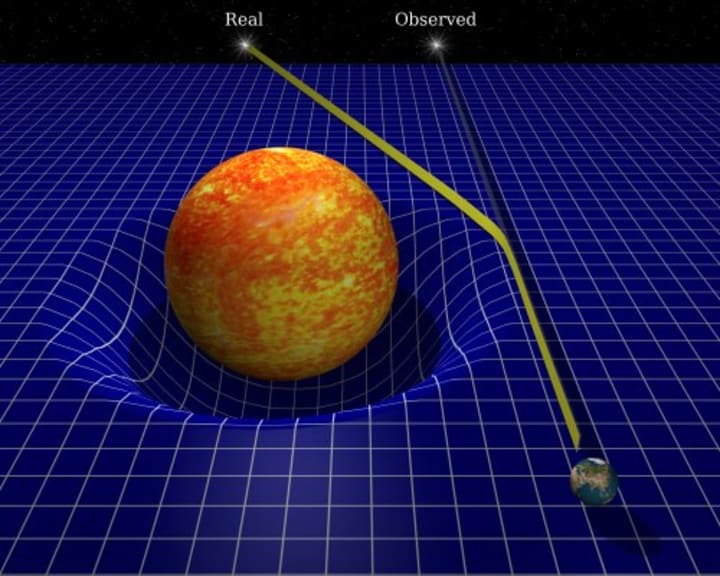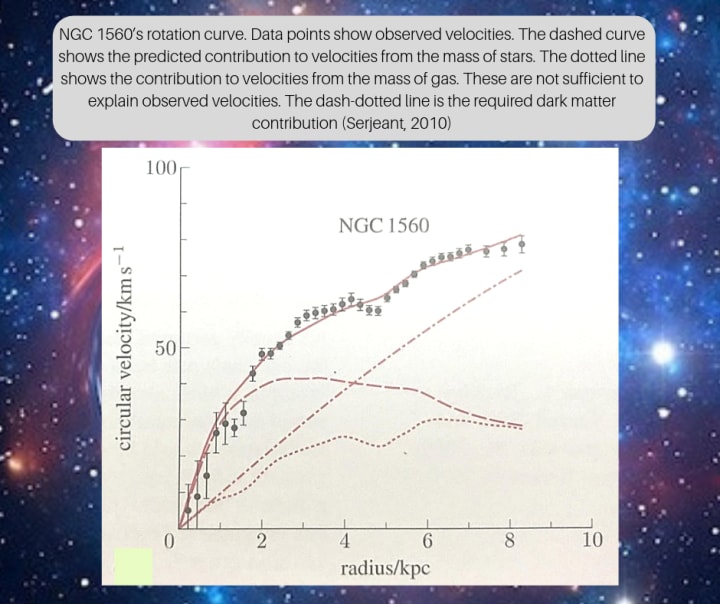Dark Matter: How We Know It's There
Although scientists are uncertain what dark matter actually is, we have developed several reliable methods to infer its presence and its location. We may not know what it is, but we know it’s there and where ‘there’ is.

Despite all of our advancements in science, physics, and astronomy, we still don’t know what approximately 80%-90% of the matter in the Universe is. But this isn’t a completely hopeless situation; there is a great deal we do know about this mysterious substance, provisionally named dark matter. For example, we know it’s there and we know where it is.
Before examining the methods that have allowed us to conclude the existence of dark matter, let’s first establish what we mean when we say "dark matter." Essentially, by this term we mean matter that we can’t see—either because it is obscured by dust and gas, it’s too dim to see or it doesn’t absorb and emit photons in the way we experience with the everyday matter all around us.
About 15% of the mass of matter we can’t see is accounted for by baryonic matter — the kind of matter that surrounds us every day — which is obscured or too dim to see. The other 80–90% is something that we don’t experience in our everyday lives; or if it is, it's behaving in a way that is alien to us.
We can be pretty sure that it is non-baryonic — it isn’t made up of protons and neutrons —and it’s dark because it doesn’t interact with photons.
It is this non-luminous, non-baryonic matter that we are generally referring to when we say "dark matter," and it’s the definition we’ll be using going forward. Also, worth pointing out — we don’t know what it is.
That doesn’t mean that we are completely in the dark, however. We know that this mass is there; we can infer its presence by the gravitational effect it has on the matter we can see. We are also able to ascertain some of the characteristics of this dark matter.
We know it doesn’t interact with light. We know it passes through other matter and dark matter as if it isn’t even there.
The question still remains though, how can we be sure that there is actually something there to be discovered? Does dark matter exist at all, or is it possible that we could be wrong about our theories of gravity on large scales instead?
Mystery of the Missing Mass
The need for some other "unseen" mass in the Universe was first raised by Fritz Zwicky in 1933. After studying the Coma Cluster of galaxies, Zwicky argued that most of the gravitational mass in that cluster was not in the form of stars and gas, but in some dark form only detectable through its gravitational effects.

Fritz Zwicky; the father of dark matter (Swiss Physical Society)
Zwicky — a Swiss astronomer who spent most of his working life at the Califonia Institute of Technology (CalTech) in the US — used a method known as virial theorem to infer the gravitational mass of the Coma Cluster, finding that the combined mass of the stars and gas in the system simply wasn’t great enough to hold it together gravitationally.
The basis of virial theorem is that the magnitude of gravitational energy within a system is equal to twice the kinetic energy. Using this as a starting point, it’s relatively straightforward to calculate the mass of a system if you know its velocity — which can be measured using Doppler shifts.

The strongest supportive evidence of the existence of dark matter comes from the measurement of the rotation curve of the spiral galaxy NGC 1560.
Of course, a result such as Zwicky’s should be replicable by other methods. Thankfully, we have several different techniques to determine the mass of galaxies and galactic clusters.
Evidence of a galaxy’s mass is also provided by gravitational lensing. Einstein’s theory of general relativity predicts that mass warps the very fabric of space-time. The greater the mass, the greater the warpage. The easiest way to explain this is to imagine placing different weighted objects on a stretched rubber sheet and looking at the resulting bend created in the sheet.

A basic representation of gravitational lensing
Even light follows these deviations, meaning that the light from distant galaxies is curved as it passes other galaxies and galactic clusters. The degree of curvature is an indication of the magnitude of the intervening mass.
This results in galaxies appearing displaced or even, in extreme cases, appearing at multiple points in the sky due to the different paths the light takes to reach Earth.
The strongest supportive evidence for dark matter contents is in the local Universe. The rate of rotation of spiral galaxies can be used to infer the mass enclosed within that galaxy. The velocity of the stars and gas of a galaxy expressed as a function of the radius of the spiral is known as the rotation curve.
If there were no dark matter, the rotation curve would agree with predictions made from the stars and gas. The diagram below shows the measured rotation curve of the spiral galaxy NCG 1560. The contributions to the velocities made by the total mass of both gas and stars are insufficient to explain the total rotation curve.

Even if we take this as clear evidence of missing mass in the Universe, the skeptic may ask, “Why does this mean that mass must be in some form we are unaware of? Isn’t it a possibility that this mass is simply non-luminous baryonic matter? What if there are some flaws in our understanding of gravity? What if this is matter locked up in black holes?”
The fact that gas in a galaxy and the dark matter of that galaxy occupy the same space implies that there could be a revision of gravitational theories that could do away with the need for dark matter. Several revised versions of Newtonian mechanics, such as Modified Newtonian Dynamics (MOND), have been put forward.
To confirm the need for dark matter and reject MOND and equivalent alternative hypotheses, we would have to observe a situation where gas and dark matter have been separated. Fortunately, such a scenario is provided by collisions between clusters of galaxies, such as the one detailed below.
The Bullet Cluster: Direct Empirical Evidence of Dark Matter
The presence of dark matter has been inferred by its gravitational effects as detailed above, but the need for a new form of matter rather than a revision to our current understanding is provided by observations of the galaxy cluster 1EO657–558 or the Bullet Cluster.
The Bullet Cluster is the remnant of two sub-clusters which underwent a collision roughly 100 million years ago. X-ray examination of the Bullet Cluster shows intracluster gas caught between the sub-clusters, behaving exactly as we would expect. They have been pressed together and slowed their progress towards the edges of the cluster.
Observations made using gravitational lensing reveal that the dominant masses in the Bullet Cluster have behaved quite differently to the gas. This mass has become separated from the intracluster gas. In fact, we can see that the clusters of dark matter have passed through the other material and even each other to form two ‘peaks.'

Images (Lambourne, Jones, Serjeant (2009))
This behaviour can’t be explained by a modified theory of gravity, nor can this ghostly phasing be displayed by baryonic matter. Dark matter exists. But where is it?
The Hunt Is on: Methods to Find Dark Matter
To locate dark matter, we turn to Einstein and his theory of general relativity; more precisely, we use weak gravitational lensing. In this case, we look for the distortions in distant background galaxies caused by intervening dark matter.
To describe this using an everyday analogy, imagine staring at the bottom of a swimming pool that has a grid pattern on it. If the pool is still, you would see the grid pretty much as it is on the bottom of the pool. If the surface of the water is turbulent, however, you would see the grid distorted and misshapen.
To put this on a cosmological scale, we can picture a field of perfectly circular galactic clusters viewed through a web of dark matter. Distortions in the shape of the clusters indicate the presence of dark matter, so the larger the distortion, the greater the concentration of dark matter. These distortions are referred to as cosmic shear.

(A. Refrieger, University of Cambridge)
Even though outside of this hypothetical situation galaxies are rarely perfectly circular, if ever, and the actual shear is extremely small, astronomers can average the distortion over several galaxies closely positioned in the sky.

Schematic of Milky Way showing the dark matter halo (grey), globular clusters (red circles), the thick disk (dark purple), the stellar disk (white), the stellar bulge (red-orange), and the central black hole. The stellar disk is about 100,000 light years in diameter. The dark halo extends to a diameter of at least 600,000 light years. (NASA/CXC/M. Weiss)
In the case of our own Milky Way, we have been able to determine that dark matter exists in an oblique halo surrounding the disc of our galaxy. We’ve been able to determine that its mass is approximately 10¹² solar masses, 10 times the mass of the Milky Way’s stars and 100 times the mass of its gas and dust. From this, we can be certain that it is the gravitational influence of dark matter that holds our galaxy and others together.
Though we don’t exactly know what dark matter is, there’s a great deal we do know, and there's even more we can infer. The coming decades hold promise to solve one of the greatest mysteries of science, the nature of dark matter will likely be revealed, and it may be that the answer just leaves us with more questions.
About the Creator
Robert Lea
Freelance science writer/journalist. Space. Physics. Astronomy. Quantum physics. Member of the ABSW. Follow me at https://twitter.com/sciencef1rst






Comments
There are no comments for this story
Be the first to respond and start the conversation.